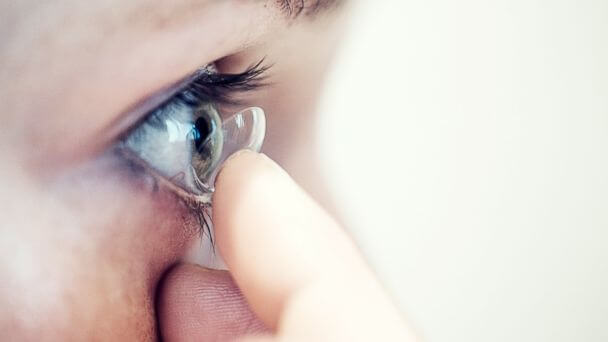
Specialty contact lenses can help with everything from improving symptoms of Dry Eye Disease to providing clear vision to people with a higher degree of astigmatism. They’re designed for patients with corneal conditions or other eye issues for which conventional contacts are ineffective.
Rigid Gas Permeable Lenses
RGP lenses are made of firm, oxygen-permeable material and have several advantages over traditional soft contact lenses. It may appear that “soft” is the natural choice for something that will come into contact with your eye, but this isn’t always the case.
RGP lenses were the first type of lenses prescribed to patients suffering from conditions such as keratoconus. They are also used for higher prescriptions and greater amounts of astigmatism.
RGP lenses are oxygen-permeable, allowing air to pass through and allowing your eyes to “breathe.” Because the materials used to make these lenses allow more oxygen to pass through, they provide a better oxygen supply.
Furthermore, because they are smaller than soft lenses and thus cover less of the surface of the eye, they allow moisture and oxygen to circulate beneath the lens, making them a good option for people suffering from Dry Eye Disease.
Scleral Contact Lenses
Scleral contact lenses are larger in diameter than traditional contacts, but instead of sitting directly on the surface of the eye, they vault over it, leaving a gap between the cornea and the lens.
Scleral lenses are an effective solution for a variety of issues that make wearing regular contact lenses impractical or impossible.
The space allows patients with corneal abnormalities such as keratoconus or surgical scarring to wear contact lenses. It also serves as a reservoir for tear film, keeping it on the surface of the eyes for longer and alleviating dry eye symptoms.
Soft Contact Lenses
Toric Lenses
Toric lenses are appropriate for people who have:
- Astigmatism
- Presbyopia
- Dry eye syndrome
- Corneal scarring
- Giant papillary conjunctivitis
- Pellucid marginal degeneration
- Keratoconus
These specialty soft contacts are shaped differently than standard lenses, which have a more beachball appearance. The toric lens is geometrically shaped to create refractive strength depending on how you move. These lenses are ideal for people with astigmatism because they conform to the exact curvature of your eye.
Multifocals
Soft multifocal lenses can be used to treat both astigmatism and presbyopia. Some styles can be worn for up to a week without being removed, while others must be removed every night. Some lenses are disposable, which means you replace them every day, while others require daily lens care.
Hybrids
Hybrid lenses combine the best of both worlds in a single lens with a rigid center surrounded by a soft lens skirt. These lenses offer the comfort of soft lenses as well as the visual quality of RGP lenses.
Hybrid lenses are ideal for patients who have corneal astigmatism or presbyopia with astigmatism; they also work well for people who have difficulty achieving optimal vision with soft lenses or are concerned about the comfort of RGP lenses.
Advantages of Hybrid Lenses
Comfort
RGP lenses are typically not as comfortable as hybrid lenses. While many people wear hard contact lenses without issue daily, others are bothered by the sensation of these lenses in their eyes.
People with highly irregular corneas in particular find it difficult to adjust to the sensation of rigid lenses. Hybrid lenses provide a more comfortable compromise on the eye and are more comfortable to wear for extended periods.
Stability
Soft lenses are not as stable as hybrid lenses. Because the center of a hybrid lens is made of rigid material, it doesn’t change shape when placed on the ocular surface and can help to neutralize corneal irregularities.
This stability reduces or eliminates the issue of soft lenses moving around or adopting an irregular corneal shape, resulting in uncorrected irregular astigmatism.
Which Specialty Contact Lens Will Work for You?
Credits to Dr. David Kading and specialtyeye.com
